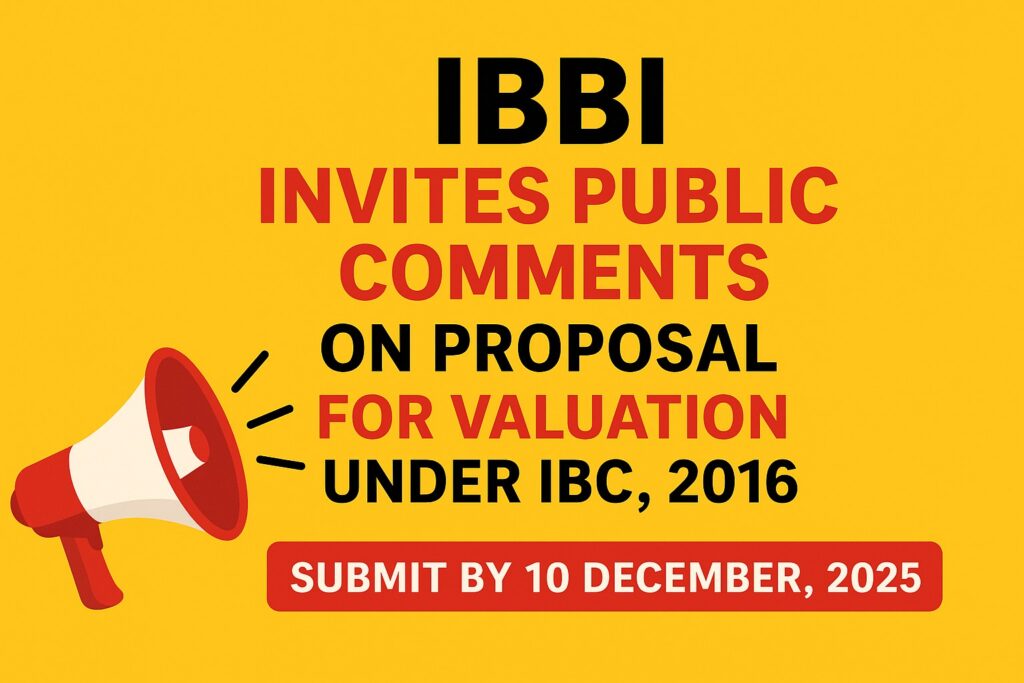IBBI PROPOSES STANDARDISED ASSET VALUATION FORMAT
TO PROMOTE CONSISTENCY, TRANSPARENCY, AND STANDARDISATION IN VALUATIONS CARRIED OUT UNDER THE CODE
A Detailed Information Update by the Council of Engineers and Valuers (CEV)
📢 IMPORTANT ANNOUNCEMENT FOR ALL IBBI REGISTERED VALUERS!
SUMMARY
IBBI Proposes Standardized Asset Valuation
The Insolvency and Bankruptcy Board of India (IBBI) has proposed a standardized asset valuation format to reduce litigation and strengthen bankruptcy resolution under the Insolvency and Bankruptcy Code (IBC) 2016. The proposal invites public comments by December 10, 2025, aiming to streamline valuation processes and enhance the efficiency of bankruptcy proceedings.
IBC Valuation Format Draft Review
The Insolvency and Bankruptcy Board of India has released an additional draft paper on valuation formats under the IBC 2016, inviting public comments by December 10, 2025. The initiative aims to standardize valuation reports, ensure uniform documentation, enhance transparency, and reduce disputes in the IBC process. All IBBI-registered valuers, regulatory officers, insolvency professionals, creditors, academicians, and stakeholders are encouraged to review and submit comments to improve the final guidelines.
IBBI Valuation Guidelines Comment Process
CEV provided a step-by-step guide on how to submit comments to the IBBI regarding the proposed guidelines for conducting valuation under IBC 2016. The process involves visiting the IBBI website, navigating to the public comment section, selecting the relevant discussion paper, entering basic details, typing comments, and submitting them by December 10, 2025. CEV emphasized the importance of reviewing and supporting the evaluation profession by providing valuable feedback.
Valuation Guidelines Review Initiative
CEV requested all registered valuers and stakeholders to review and submit comments on the draft guidelines to support the valuation ecosystem. They encouraged sharing practical, technical, and regulatory insights to help shape a balanced and professional valuation system. A video tutorial was provided at the end of the meeting to demonstrate how to log into the IBBA website and submit comments.
IBBI Refines Valuation Framework
The Insolvency and Bankruptcy Board of India (IBBI) has issued an additional draft paper on valuation formats, further refining the framework for valuation under the Insolvency and Bankruptcy Code 2016. The proposed guidelines aim to bring consistency, uniformity, and objectivity to the valuation exercise, ensuring comprehensive, transparent, and well-documented valuation reports. This step is intended to enhance confidence among creditors, educate authorities, and improve the quality, credibility, and reliability of valuation outcomes in India’s insolvency ecosystem.
Uniform Valuation Report Proposal
The Insolvency and Bankruptcy Board of India has released a proposal for a uniform valuation report format to enhance credibility and reduce litigation under the Insolvency and Bankruptcy Code 2016. The new draft, open for public comment until December 10, aims to address concerns about varying valuation reports and frequent legal challenges. The initiative follows years of stakeholder concerns regarding inconsistencies in valuation documentation and methodologies.
IBC Valuation Guidelines Consultation
The Council of Engineers and Valuers (CEV) is conducting a consultation exercise inviting all registered valuers, stakeholders, and professionals to provide feedback on draft guidelines for valuation under the Insolvency and Bankruptcy Code (IBC). The consultation aims to shape the future of valuation practices in India, with a deadline set for December 10th. CEV encourages valuation professionals to study the draft guidelines, identify challenges, and submit structured comments by the deadline to contribute to a stronger, more transparent valuation ecosystem.
The Insolvency and Bankruptcy Board of India (IBBI) has released an additional Draft Paper on Valuation Formats under the IBC, 2016 and invited public comments!
📝 Last date to submit: 10 December 2025
This initiative aims to strengthen the valuation ecosystem by:
✔ Standardising valuation report formats
✔ Ensuring uniformity in documentation
✔ Enhancing transparency & credibility in the IBC process
✔ Reducing disputes in valuation outcomes
📌 Action Required:
All RVs, RVOs, IPs, creditors, academicians, and stakeholders are encouraged to review & submit comments to improve final guidelines.
Let’s make our voice heard and contribute to stronger valuation standards in India!
— A public awareness message by CEV / CEV IAF RVO
🔗 Visit: www.ibbi.gov.in → Public Comments
🗓 Deadline: 10 December 2025
📍 Your participation matters!
#Valuation #IBBI #IBC2016 #RegisteredValuers #CEV #ValuationStandards #PublicComments #InsolvencyResolution
🧭 STEP-BY-STEP GUIDE
👉 How to Submit Your Comments to IBBI (Simple Process)
Follow these easy steps and ensure your valuable feedback is registered:
🖥 Step 1: Visit Official Website
Go to: www.ibbi.gov.in
📂 Step 2: Open Public Comments Section
Navigate to:
Menu → Public Comments
📌 Step 3: Select Relevant Paper
Choose:
“Discussion Paper on Proposed Guidelines for Conducting Valuation under IBC, 2016”
(19 November 2025 release)
🧑💼 Step 4: Enter Basic Details
Fill in:
✔ Name
✔ Email ID
✔ Stakeholder Category:
✍ Step 5: Type of Comments
Choose one:
1️⃣ General Comments
-
Select issue category like inconsistency, implementation difficulty etc.
2️⃣ Specific Comments
-
Choose paragraph/sub-para & mention your specific suggestion
➕ Step 6: Add Additional Observations
Click “More Comments” to submit additional points if required.
📨 Step 7: Submit
Click SUBMIT
✔ Confirmation message will appear
✔ Your feedback will be recorded
📅 REMEMBER: Deadline is 10 December 2025
⏳ Don’t wait! Review → Comment → Support the valuation profession!
🎯 CEV’s Request to All Members
CEV encourages all Registered Valuers & stakeholders to:
🔍 Carefully review the draft Guidelines
🗣 Share practical, technical, and regulatory insights
🤝 Help shape a balanced and professional valuation system
Together —Let’s strengthen the future of valuation under India’s IBC!
New Delhi, November 2025 — In an important development for India’s insolvency-valuation ecosystem, the IBBI has issued an additional Draft Paper on Valuation Formats, further refining the framework for valuations under the Insolvency and Bankruptcy Code, 2016 (IBC). This step builds on its earlier “Discussion Paper on Proposed Guidelines for Conducting Valuation under IBC, 2016”, issued on 19 November 2025. The new draft is open for public comment — and the deadline is set for 10 December 2025.
The new Guidelines aim to ensure that valuations conducted for corporate insolvency, resolution, or liquidation under IBC are consistent, transparent, and robust, thereby strengthening confidence among creditors, investors, adjudicating authorities, and valuers themselves.
In a significant policy development expected to reshape the framework of insolvency valuation in India, the Insolvency and Bankruptcy Board of India (IBBI) has released a proposal for a uniform valuation report format for all professionals undertaking valuations under the Insolvency and Bankruptcy Code (IBC), 2016.
The objective: to enhance credibility, reduce inconsistencies, and minimise litigation arising out of valuation disputes in bankruptcy cases.
This move follows years of concerns expressed by stakeholders regarding variations in valuation reports, lack of uniform documentation, and frequent legal challenges questioning the methodology and professional judgement applied by Registered Valuers (RVs).
Why This Matters: Need for Standardised Valuation Formats
Historically, valuations under IBC have been criticized for variability in approach, format, documentation, and reasoning — leading in several cases to disputes, litigation, or challenges by stakeholders. Differences in valuation reports, lack of uniform structure, inadequate documentation, or opaque assumptions have often undermined confidence in the valuation process.
Recognizing these concerns, IBBI has sought to institutionalize a uniform format and documentation standard. The new draft Guidelines aim to:
-
Bring uniformity across all valuations under IBC, regardless of asset class.
-
Ensure reports are comprehensive, evidence-backed, and logically structured.
-
Facilitate better comparability and clarity, reducing scope for disputes.
-
Strengthen the professional credibility and accountability of Registered Valuers (RVs).
For the valuing community — especially Registered Valuers, Valuer Entities, insolvency professionals, creditors, and other stakeholders — this is a critical moment to engage actively and influence the final regulation.
Why a Standardised Valuation Format Now?
Valuation has long been recognised as one of the most critical components of the insolvency resolution process. The value assigned to a distressed enterprise directly influences key decisions such as:
-
Whether revival of the corporate debtor is feasible
-
Determination of liquidation value and fair value
-
Assessment of recovery potential for creditors
-
Negotiations with potential investors
Given the high stakes, valuation reports have become central documents in insolvency proceedings. However, non-standardised formats and insufficient disclosures have often resulted in valuation reports becoming the subject of litigation, delaying resolution and creating uncertainty.
The newly proposed guidelines aim to eliminate ambiguities, ensure uniformity, and mandate rigorous documentation, thereby fortifying the integrity of the valuation process.
What the Draft Format Requires: Key Enhancements
According to the IBBI’s proposal, the new format significantly expands the scope of disclosures and documentation required from valuation professionals. Key features include:
1. Enhanced Risk Disclosures
Valuers must explicitly state:
-
The risks involved in the valuation
-
Limitations affecting the assessment
-
Sensitivities around assumptions or market conditions
2. Conflict of Interest Declarations
To promote independence and trust, valuers must clearly disclose:
-
Any personal, professional, or financial interests
-
Any prior association with the corporate debtor or stakeholders
3. Documentation and Evidence Requirements
The proposed guidelines mandate that valuation reports must be backed by:
4. Standardised Structure for the Valuation Report
The new report format will include:
-
Executive summary
-
Scope of valuation
-
Methodology applied and rationale
-
Key assumptions and limitations
-
Detailed working papers
-
Market trends and economic influences
-
Asset-class specific schedules
5. Focus on Recoverability Factors
The guidelines instruct valuers to consider:
Given the growing complexity of insolvency cases, this structured format is expected to bring consistency and clarity across all report submissions.
Industry Experts Welcome the Move
The valuation community and insolvency ecosystem have largely welcomed the reforms.
“The new guidelines will bring consistency, transparency, and standardisation, resulting in valuation reports that are well-reasoned and backed by sufficient evidence. They will significantly improve the quality of decision-making for resolution professionals.”
Another senior valuation professional echoed this sentiment, emphasising that while the standardised format will drastically improve efficiency and reduce disputes, real-world challenges persist:
“The proposal is a welcome step that will elevate transparency and credibility. It will also reduce disagreements of the kind seen in cases like Ramkrishna Forgings Ltd. and other high-profile insolvency matters. However, complexities in data availability, distressed-asset behaviour and uncertain market conditions remain ongoing challenges for valuers.”
Reducing Litigation and Strengthening Creditor Confidence
The IBBI noted that the introduction of a uniform valuation structure is critical, especially as valuation reports have often been scrutinised in courts during bankruptcy cases.
A structured, comprehensive report backed by standardised disclosures is expected to:
-
Reduce valuation-related disputes
-
Improve comparability among reports
-
Enhance investor confidence
-
Facilitate faster and more informed negotiations
-
Assist creditors in achieving better recoveries
The Council of Engineers and Valuers (CEV) emphasised that a more accurate, evidence-backed, and standardised valuation document will provide creditors with a clearer picture of the corporate debtor’s financial standing, ultimately enabling better recovery outcomes.
Public Comments Invited Until 10 December 2025
To ensure broad stakeholder participation, IBBI has invited public comments on the proposed format until 10 December 2025.
Stakeholders can submit feedback through the “Public Comments” section on the IBBI website by selecting the relevant discussion paper, stakeholder category, and specifying whether their comments are general or specific.
Given the profound impact of valuation quality on insolvency outcomes, CEV encourages all Registered Valuers, RVOs, insolvency professionals, financial creditors, academics, and practitioners to positively contribute to shaping the final guidelines.
A Transformational Step for India’s Insolvency Ecosystem
The proposed standardised valuation format marks a landmark effort by IBBI to strengthen the credibility, transparency, and uniformity of the valuation ecosystem under the Insolvency and Bankruptcy Code.
If implemented effectively, it can significantly streamline the resolution process, reduce litigation, and support more robust decision-making by all stakeholders.
As a professional body committed to advancing valuation excellence, the Council of Engineers and Valuers (CEV) recognises the proposal as a timely and progressive step that will ultimately enhance the reliability and integrity of the insolvency framework in India.
IBBI Issues Draft Guidelines for Conducting Valuation Under the Insolvency and Bankruptcy Code, 2016



